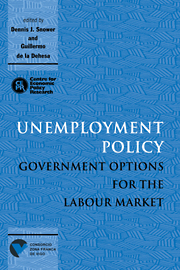Book contents
- Frontmatter
- Contents
- List of figures
- List of tables
- Preface
- Acknowledgements
- List of conference participants
- 1 Introduction
- PART ONE GENERAL POLICY ISSUES
- PART TWO DEMAND MANAGEMENT AND SUPPLY-SIDE POLICY
- PART THREE SUBSIDISING EMPLOYMENT AND TRAINING
- PART FOUR LABOUR MARKET REGULATIONS
- PART FIVE POLICY, JOB REALLOCATION AND THE UNEMPLOYMENT–PRODUCTIVITY RELATION
- PART SIX COMPARING UNEMPLOYMENT POLICIES
- 16 Unemployment in the OECD and its remedies
- Discussion
- Discussion
- 17 The unemployment and welfare effects of labour market policy: a comparison of the USA and the UK
- Discussion
- Discussion
- Index
Discussion
Published online by Cambridge University Press: 07 September 2010
- Frontmatter
- Contents
- List of figures
- List of tables
- Preface
- Acknowledgements
- List of conference participants
- 1 Introduction
- PART ONE GENERAL POLICY ISSUES
- PART TWO DEMAND MANAGEMENT AND SUPPLY-SIDE POLICY
- PART THREE SUBSIDISING EMPLOYMENT AND TRAINING
- PART FOUR LABOUR MARKET REGULATIONS
- PART FIVE POLICY, JOB REALLOCATION AND THE UNEMPLOYMENT–PRODUCTIVITY RELATION
- PART SIX COMPARING UNEMPLOYMENT POLICIES
- 16 Unemployment in the OECD and its remedies
- Discussion
- Discussion
- 17 The unemployment and welfare effects of labour market policy: a comparison of the USA and the UK
- Discussion
- Discussion
- Index
Summary
In many recent models of unemployment the role of trade is peripheral. In Layard et al. (1991), for example (hereafter LNJ), unemployment is the outcome of the interaction between labour demand (or price-setting) and a wage-setting mechanism. Trade shocks might shift labour demand, or wage-setting if the consumer/producer price wedge is altered. The results reported by LNJ generally assign trade a small role in explaining the rise in unemployment in the OECD (see, e.g. p. 433).
By contrast, Minford seeks to place trade centre-stage in explaining OECD unemployment and wage inequality. The thrust of Minford's argument, which uses the Heckscher–Ohlin–Samuelson (HOS) model, can be seen as follows. There are two countries, the UK, whose population is predominantly skilled, and China, predominantly unskilled. Manufactured goods, whose production is unskilled labour intensive, are traded freely. Complex/high-tech goods, which are skilled labour-intensive, are non-traded. Minford considers the shock of main interest to be a progressive transfer of technology from the UK to Chinese manufacturing. Such a productivity increase lowers the relative price of manufactured goods in China. This worsens the terms of trade for manufactured goods in the UK, and so causes the UK to shift production towards skill-intensive goods. In turn, this raises the relative demand for skilled worker and so their relative wage (a Stolper-Samuelson-type effect). The rise in the relative skilled wage causes their relative employment to fall in all industries; the skilled workers required in the expanded skill-intensive sector are provided by economising on their use when they become relatively more expensive.
- Type
- Chapter
- Information
- Unemployment PolicyGovernment Options for the Labour Market, pp. 534 - 541Publisher: Cambridge University PressPrint publication year: 1997



